SLC12A1 / NKCC2 Recombinant Rabbit Monoclonal Antibody [JE64-26]

cat.: HA721906
| Product Type: | Recombinant Rabbit monoclonal IgG, primary antibodies |
|---|---|
| Species reactivity: | Human, Mouse, Rat |
| Applications: | WB, IHC-P, IF-Cell, mIHC |
| Clonality: | Monoclonal |
| Clone number: | JE64-26 |
| Form: | Liquid |
| Storage condition: | Shipped at 4℃. Store at +4℃ short term (1-2 weeks). It is recommended to aliquot into single-use upon delivery. Store at -20℃ long term. |
| Storage buffer: | 1*TBS (pH7.4), 0.05% BSA, 40% Glycerol. Preservative: 0.05% Sodium Azide. |
| Concentration: | 1ug/ul |
| Purification: | Protein A affinity purified. |
| Molecular weight: | Predicted band size: 121 kDa |
| Isotype: | IgG |
| Immunogen: | Recombinant protein within Human SLC12A1 / NKCC2 aa 593-813 / 1,099. |
| Positive control: | Mouse kidney tissue lysate, rat kidney tissue lysate, K-562 cell lysate, mouse kidney tissue, K-562. |
| Subcellular location: | Cell membrane |
| Recommended Dilutions:
WB IHC-P IF-Cell mIHC |
1:2,000 1:20,000 1:100 1:3,000 |
| Uniprot #: | SwissProt: Q13621 Human | P55014 Mouse | P55016 Rat |
| Alternative names: | BSC1 Bumetanide sensitive sodium 3 Bumetanide-sensitive sodium-(potassium)-chloride cotransporter 2 Kidney specific Na K Cl symporter Kidney-specific Na-K-Cl symporter MGC48843 Na K 2Cl cotransporter NKCC2 potassiumchloride cotransporter 2 S12A1_HUMAN Slc12a1 sodium potassium chloride cotransporter 2 solute carrier family 12 (sodium/potassium/chloride transporters) Solute carrier family 12 member 1 |
Images
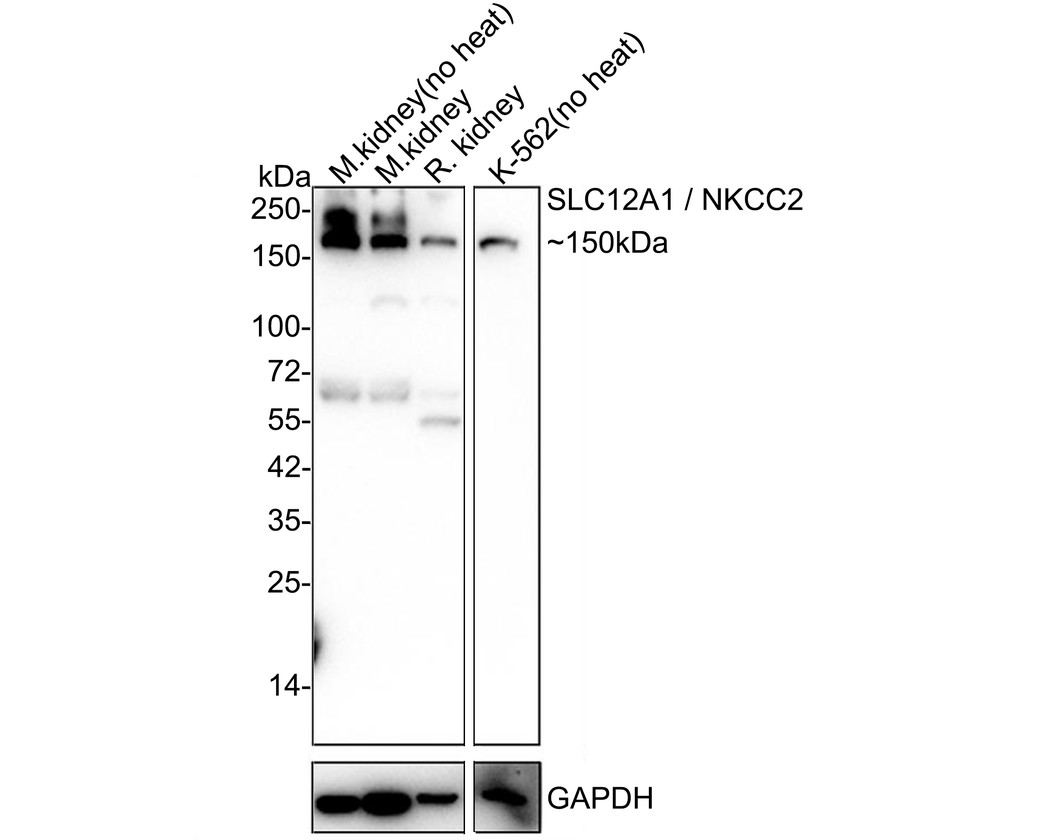
|
Fig1:
Western blot analysis of SLC12A1 / NKCC2 on different lysates with Rabbit anti-SLC12A1 / NKCC2 antibody (HA721906) at 1/1,000 dilution. Lane 1: mouse kidney tissue lysate (no heat) Lane 2: mouse kidney tissue lysate Lane 3: rat kidney tissue lysate Lane 4: K-562 cell lysate (no heat) Notice: no heat means the lysate is not boiled. Tissue lysates at 30 µg/Lane. Cell lysates at 20 µg/Lane. Predicted band size: 121 kDa Observed band size: 150 kDa Exposure time: 1 minutes 40 seconds; 4-20% SDS-PAGE gel. Proteins were transferred to a PVDF membrane and blocked with 5% NFDM/TBST for 1 hour at room temperature. The primary antibody (HA721906) at 1/1,000 dilution was used in 5% NFDM/TBST at room temperature for 2 hours. Goat Anti-Rabbit IgG - HRP Secondary Antibody (HA1001) at 1/50,000 dilution was used for 1 hour at room temperature. |
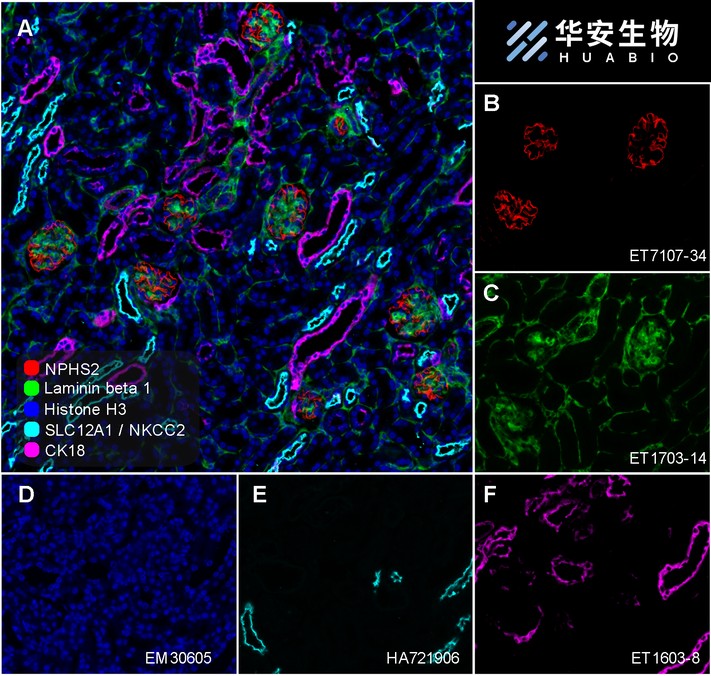
|
Fig2: Fluorescence multiplex immunohistochemical analysis of mouse kidney (Formalin/PFA-fixed paraffin-embedded sections). Panel A: the merged image of anti-NPHS2 (ET7107-34, Red), anti-Laminin beta 1 (ET1703-14, Green), anti-Histone H3 (EM30605, Blue), anti-SLC12A1 / NKCC2 (HA721906, Cyan) and anti-CK18 (ET1603-8, Magenta) on kidney. HRP Conjugated UltraPolymer Goat Polyclonal Antibody HA1119/HA1120 was used as a secondary antibody. The immunostaining was performed with the Sequential Immuno-staining Kit (IRISKit™MH010101, www.luminiris.cn). The section was incubated in five rounds of staining: in the order of ET7107-34 (1/1,000 dilution), ET1703-14 (1/1,000 dilution), EM30605 (1/500 dilution), HA721906 (1/3,000 dilution) and ET1603-8 (1/3,000 dilution) for 20 mins at room temperature. Each round was followed by a separate fluorescent tyramide signal amplification system. Heat mediated antigen retrieval with Tris-EDTA buffer (pH 9.0) for 30 mins at 95℃. Image acquisition was performed with Olympus VS200 Slide Scanner. |
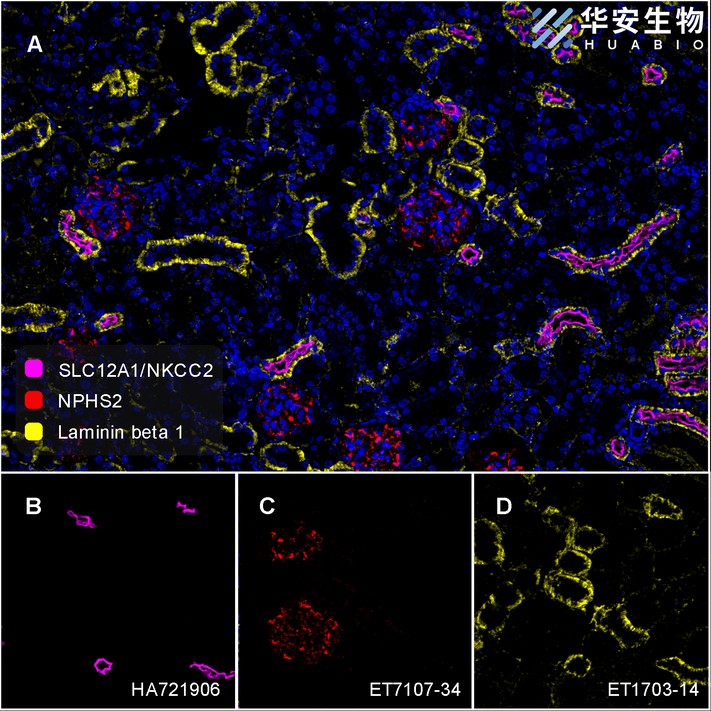
|
Fig3: Fluorescence multiplex immunohistochemical analysis of mouse kidney (Formalin/PFA-fixed paraffin-embedded sections). Panel A: the merged image of anti-Laminin beta 1 (ET1703-14, Yellow), anti-NPHS2 (ET7107-34, Red) and anti-SLC12A1/NKCC2 (HA721906, Violet) on kidney. HRP Conjugated UltraPolymer Goat Polyclonal Antibody HA1119/HA1120 was used as a secondary antibody. The immunostaining was performed with the Sequential Immuno-staining Kit (IRISKit™MH010101, www.luminiris.cn). The section was incubated in three rounds of staining: in the order of ET1703-14 (1/1,000 dilution), ET7107-34 (1/1,000 dilution) and HA721906 (1/3,000 dilution) for 20 mins at room temperature. Each round was followed by a separate fluorescent tyramide signal amplification system. Heat mediated antigen retrieval with Tris-EDTA buffer (pH 9.0) for 30 mins at 95℃. DAPI (blue) was used as a nuclear counter stain. Image acquisition was performed with Zeiss Observer 7 Inverted Fluorescence Microscope. |
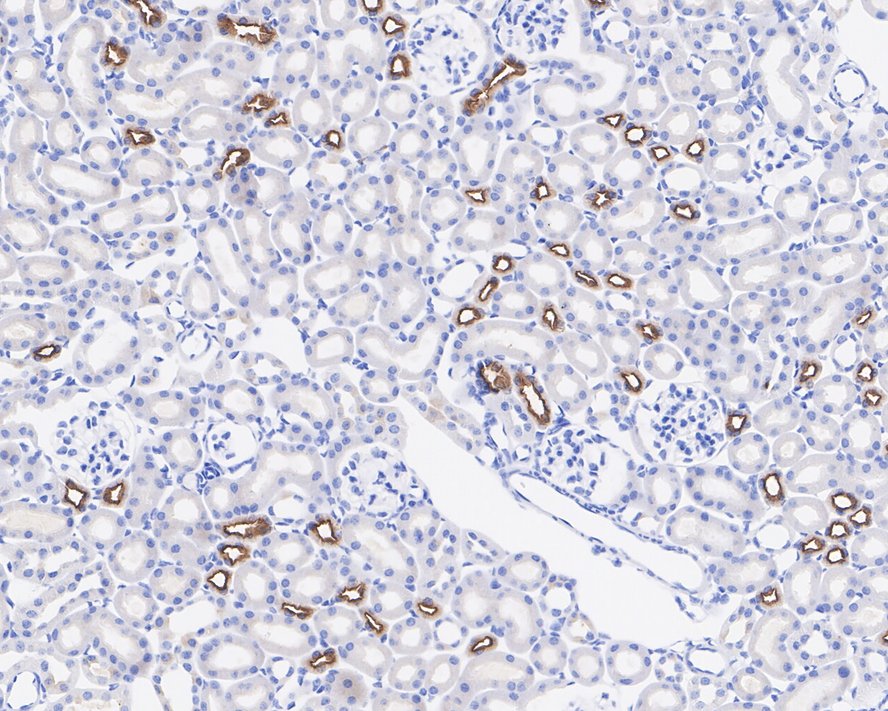
|
Fig4:
Immunohistochemical analysis of paraffin-embedded mouse kidney tissue with Rabbit anti-SLC12A1 / NKCC2 antibody (HA721906) at 1/20,000 dilution. The section was pre-treated using heat mediated antigen retrieval with Tris-EDTA buffer (pH 9.0) for 20 minutes. The tissues were blocked in 1% BSA for 20 minutes at room temperature, washed with ddH2O and PBS, and then probed with the primary antibody (HA721906) at 1/20,000 dilution for 1 hour at room temperature. The detection was performed using an HRP conjugated compact polymer system. DAB was used as the chromogen. Tissues were counterstained with hematoxylin and mounted with DPX. |
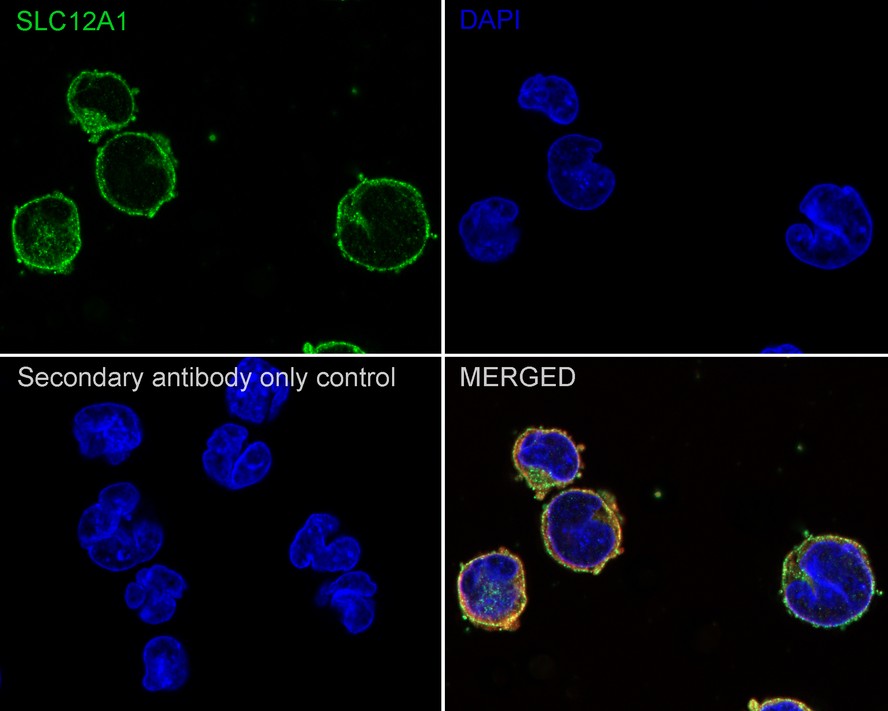
|
Fig5:
Immunocytochemistry analysis of K-562 cells labeling SLC12A1 / NKCC2 with Rabbit anti-SLC12A1 / NKCC2 antibody (HA721906) at 1/100 dilution. Cells were fixed in 4% paraformaldehyde and 80% methanol for 20 minutes at room temperature, permeabilized with 0.1% Triton X-100 in PBS for 5 minutes at room temperature, then blocked with 1% BSA in 10% negative goat serum for 1 hour at room temperature. Cells were then incubated with Rabbit anti-SLC12A1 / NKCC2 antibody (HA721906) at 1/100 dilution in 1% BSA in PBST overnight at 4 ℃. Goat Anti-Rabbit IgG H&L (iFluor™ 488, HA1121) was used as the secondary antibody at 1/1,000 dilution. PBS instead of the primary antibody was used as the secondary antibody only control. Nuclear DNA was labelled in blue with DAPI. Beta tubulin (M1305-2, red) was stained at 1/100 dilution overnight at +4℃. Goat Anti-Mouse IgG H&L (iFluor™ 594, HA1126) was used as the secondary antibody at 1/1,000 dilution. |
Note: All products are “FOR RESEARCH USE ONLY AND ARE NOT INTENDED FOR DIAGNOSTIC OR THERAPEUTIC USE”.